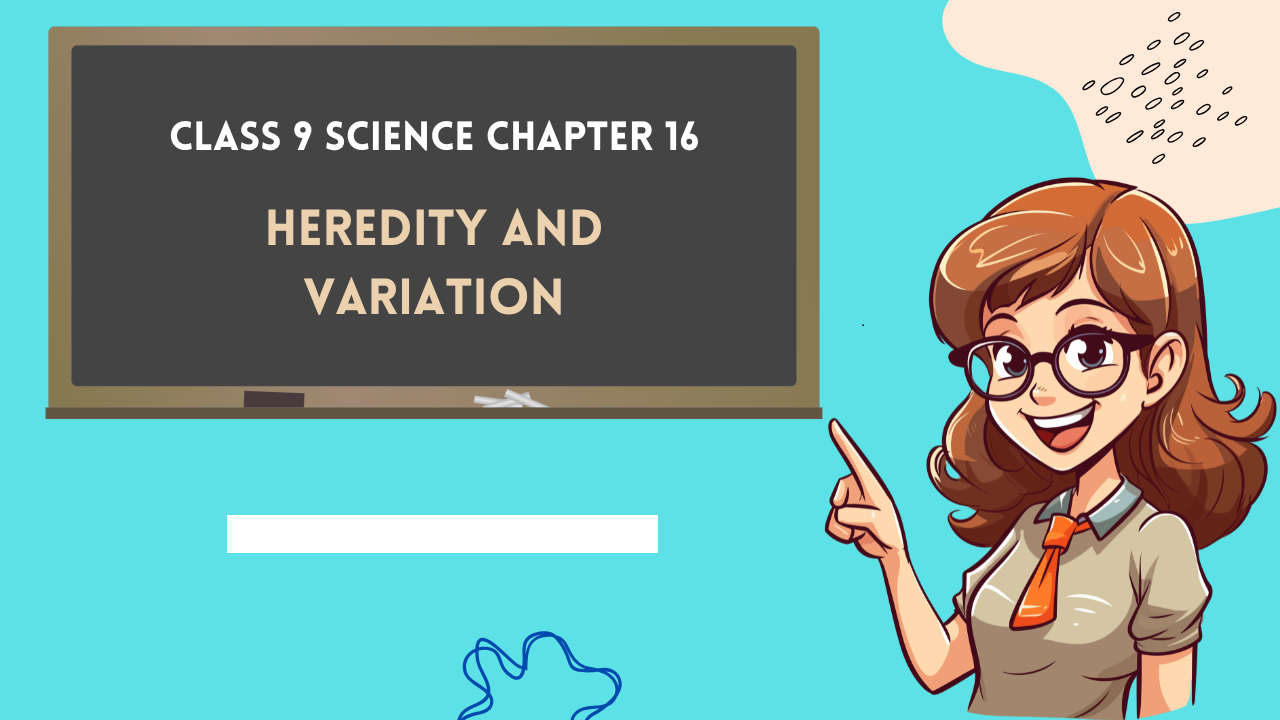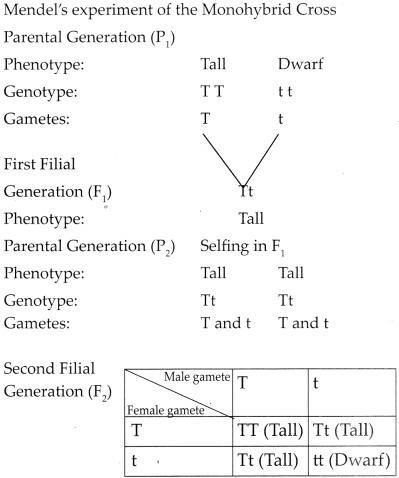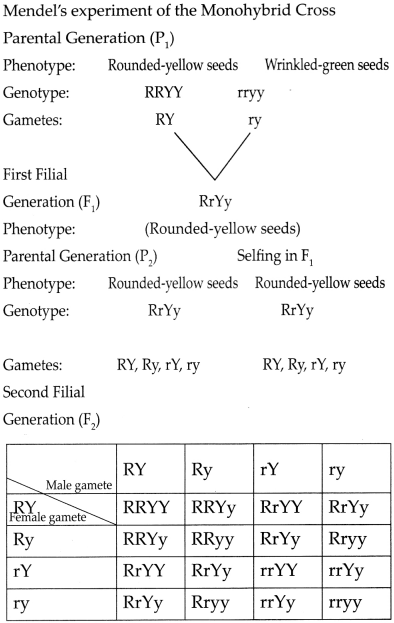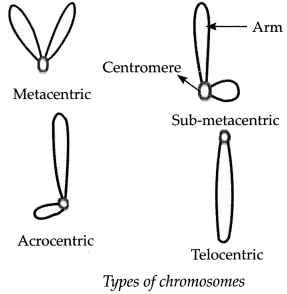Balbharti Maharashtra State Board Class 9 Science Solutions Chapter 16 Heredity and Variation Notes, Textbook Exercise Important Questions and Answers.
Std 9 Science Chapter 16 Heredity and Variation Question Answer Maharashtra Board
Class 9 Science Chapter 16 Heredity and Variation Question Answer Maharashtra Board
1. Complete the following sentences by choosing the appropriate words from the brackets.
(Inheritance, sexual reproduction, asexual reproduction, chromosomes, DNA, RNA, gene)
a. Hereditary characters are transferred from parents to offsprings by …………………………….., hence they are said to be structural and functional units of heredity.
b. Organisms produced by …………………………….. show minor variations.
c. The component which is in the nuclei of cells and carries the hereditary characteristics is called ……………………………..
d. Chromosomes are mainly made up of ……………………………..
e. Organisms produced through …………………………….. show major variations.

2. Explain the following.
a. Explain Mendel’s monohybrid progeny with the help of any one cross.
Answer:
- Mendel brought about a cross between two pea plants with only pair of contrasting characters. This type of cross is called a monohybrid cross.
-
Tall pea plants and dwarf pea plants were used in this cross. Hence this is parent generation (P
1
).
![Maharashtra-Board-Class-9-Science-Solutions-Chapter-16-Heredity-and-Variation-3]()
- All the plants produced in F 1 genration are tall, having genotype Tt. This indicates that the gene responsible for tallness in pea plants is dominant over the gene responsible for dwarfness.
- When F 1 plants are self pollinated they produce second filial generation (F 2 ).
- In F 2 generation both tall and dwarf plants appeared in the ratio 3:1.
- Thus, the genotypic ratio of F 2 generation is 3 (Tall) : 1 (Dwarf) and the genotypic ratio is 1 TT : 2 Tt: 1 tt.

b. Explain Mendel’s dihybrid ratio with the help of any one cross.
Answer:
- In dihybrid cross, Mendel considered two pairs of contrasting characters.
-
He made a cross between a pea plant producing rounded and yellow couloured seeds and a pea plant with wrinkled and green coloured seeds.
![Maharashtra-Board-Class-9-Science-Solutions-Chapter-16-Heredity-and-Variation-4]()
- All the plants produced in F 1 generation had rounded yellow seeds. This is because in pea plants, round shape of seed is dominant over wrinkled shape and yellow colour of seed is dominant over green colour.
- When F 1 plants are self pollinated, they produce four types of gamates – RY, Ry, rY, ry.
- F 2 plants formed by the fusion of four types of male gametes and four types of female gametes, had phenotypes such as round yellow, wrinkled yellow, round green and wrinkled green.
- Also, F 2 generation showed nine different types of genotypes such as RRYY, RRYy, RRyy, RrYY, RrYy, Rryy, rrYY, rrYy, rryy.
-
Phenotypic ratio of dihybrid cross is
![Maharashtra-Board-Class-9-Science-Solutions-Chapter-16-Heredity-and-Variation-5]()
-
The genotypic ratio of dihybrid cross is
![Maharashtra-Board-Class-9-Science-Solutions-Chapter-16-Heredity-and-Variation-6]()

c. Distinguish between monohybrid and dihybrid cross.
Answer:
| Monohybrid cross | Dihybrid cross |
| (i) Cross involving a single pair of contrasting characters is called monohybrid cross. | (i) Cross involving two pairs of contrasting characters is called a dihybrid cross. |
| (ii) F 1 plants of monohybrid cross produce two types of gametes. | (ii) F 1 plants of dihybrid cross produce four types of gametes. |
| (iii) Monohybrid cross has a phenotypic ratio of 3 : 1 in F 2 generation. | (iii) Dihybrid cross has a phenotypic ratio of 9 : 3 : 3 : 1 in F 2 generation. |
d. Is it right to avoid living with a person suffering from a genetic disorder?
Answer:
- No, it is not right to avoid living with a person suffering from a genetic disorder.
- Genetic disorders are transmitted from parents to offsprings only and they are non-contagious, i.e., they do not spread from one person to another through contact.
3. Answers the following questions in your own words.
a. What is meant by ‘chromosome’. Explain its types.
Answer:
- The structure in the nucleus of cells that carries the hereditary characteristics is called the chromosome.
- It is made up mainly of nucleic acids and proteins.
-
Depending upon the position of the centromere, there are four types of chromosomes.
![Maharashtra-Board-Class-9-Science-Solutions-Chapter-16-Heredity-and-Variation-7]()
(a) Metacentric: The centromere is exactly at the mid-point in this chromosome, and therefore, it looks like the English letter ‘V’. The arms of this chromosome are equal in length.

(b) Sub-metacentric: The centromere is somewhere near the mid-point in this chromosome which, therefore, looks like the English letter ‘U. One arm is slightly shorter than the other.
(c) Acrocentric: The centromere is near one end of this chromosome which therefore looks like the English letter One arm is much smaller than the other.
(d) Telocentric: The centromere is right at the end of this chromosome making the chromosome look like the English letter ‘i’. This chromosome consists of only one arm.
b. Describe the structure of the DNA molecule.
Answer:
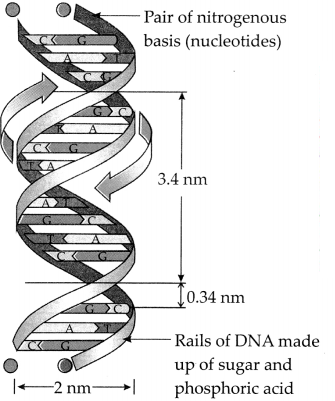
- In 1953, Watson and Crick proposed a model of the DNA molecule.
- As per their model, two parallel threads (strands) of nucleotides are coiled around each other to form a double helix structure. This structure can be compared with a coiled and a flexible ladder.
- Each strand of DNA is made up of many small molecules known as nucleotides.
- Each nucleotide is made up of a molecule of nitrogen base and phosphoric acid joined to a molecule of sugar.
- There are four types of nitrogen bases-adenine, guanine, cytosine and thymine. Adenine and guanine are called as purines while cytosine and thymine are called as pyrimidines.
- Nucleotides are arranged like a chain in the DNA.
- The two threads (strands) of the DNA are comparable to the two rails of the ladder and each rail is made up of alternately joined molecules of sugar and phosphoric acid.
- Each rung of the ladder is a pair of nitrogenous bases joined by hydrogen bonds. Adenine always pairs with thymine and cytosine always pairs with guanine.

c. Express your opinion about the use of DNA fingerprinting.
Answer:
- DNA fingerprinting is the technique in which the sequence of the genes in the DNA of a person, i.e., the genome of the person is identified.
- This technique is useful to identify the lineage and to identify criminals because it is unique to every person.
- It is also useful to identify paternity and maternity disputes etc.
- This technique was developed by Professor of genetics Sir Alec Jeffreys.
- A common method of collecting a reference sample, is in the use of a buccal swab. If this is not available, blood or saliva or hair sample may be used.
- Just like your actual fingerprint, your DNA fingerprint is something that you are born with. It is unique to you.
- DNA fingerprint is very useful in forensic science.
d. Explain the structure, function and types of RNA.
Answer:
- Ribonucleic acid (RNA) is an important nucleic acid of the cell.
- RNA is made up of ribose sugar, phosphate molecules and four types of nitrogenous bases adenine, guanine, cytosine and uracil.
- The nucleotide i.e., smallest unit of the chain of the RNA molecule is formed by the combination of a ribose sugar, phosphate molecule and one of the nitrogen bases.
- Large numbers of nucleotides are bonded together to form the macromolecule of RNA.
- RNA performs the function of protein synthesis.
-
According to function, there are three types of RNA:
(a) Ribosomal RNA (rRNA): It is the component of cellular organelle ribosome. Ribosomes perform the function of protein synthesis.(b) Messenger RNA (mRNA): It carries the information for protein synthesis from genes (i.e. DNA segment in the cell nucleus) to ribosomes (in the cytoplasm) which produce the proteins.(c) Transfer RNA (tRNA): It carries the amino acid up to the ribosomes as per the message of the mRNA.
e. Why is it necessary for people to have their blood examined before marriage?
Answer:
- If people have their blood examined before marriage, the partners will know about the possible genetic diseases that their children might inherit. So they may decide not to have children or not to get married.
- Blood tests before marriage are also done to check for any contagious disease in the partners. This will help to protect the partners from contagious diseases like STDs.
4. Write a brief note on each.
a. Down syndrome
Answer:
- Down syndrome is the disorder arising due to chromosomal abnormality.
- This is the first discovered and described the chromosomal disorder in human beings.
- This disorder is characterized by the presence of 47 chromosomes. It is described as the trisomy of the 21st pair.
-
Infants with this disorder have one extra chromosome with the 21st pair in every cell of the body. Therefore, they have 47 chromosomes instead of 46.
![Maharashtra-State-Board-Solutions]()
- Children suffering from Down syndrome are usually mentally retarded and have a short lifespan. Mental retardation is the most prominent characteristic.
- Other symptoms include short height, short wide neck, flat nose, short fingers, scanty hair, single horizontal crease on palm and a life expectancy of about 16-20 years.
b. Monogenic disorders
Answer:
- Disorders occurring due to mutation in any single gene into a defective one are called monogenic disorders.
- Approximately 4000 disorders of this type are now known.
- Due to abnormal genes, their products are either produced in insufficient quantity or not produced at all.
- It causes abnormal metabolism and may lead to death at a tender age.
- Examples of monogenic disorders are Hutchinson’s disease, Tay-Sachs disease, galactosaemia, phenylketonuria, sickle cell anaemia, cyctic fibrosis, albinism, haemophilia, night blindness etc.
c. Sickle cell anaemia: symptoms and treatment.
Answer:
- Sickle-cell anaemia is a hereditary disease caused due to mutation in a single gene. It is a monogenic disorder.
- Normal haemoglobin has glutamic acid as the 6th amino acid in its molecular structure. However, if it is replaced by valine, the shape/structure of the haemoglobin molecule, changes.
- Due to this, the erythrocytes (RBCs) which are normally biconcave become sickle-shaped. This condition is called sickle-cell anaemia. The oxygen-carrying capacity of haemoglobin in such individuals is very low.
- In this condition, clumping and thereby, destruction of erythrocytes occurs most often. As a result, blood vessels are obstructed and the circulatory system, brain, lungs, kidneys, etc. are damaged.
- Symptoms of sickle-cell anaemia are swelling of legs and hands, pain in joints, severe general body aches, frequent cold and cough, constant low-grade fever, exhaustion, pale face, low haemoglobin count.
- A person suffering from sickle-cell anaemia should take a tablet of folic acid daily.
5. How are the items in groups A, B and C inter-releated?
6. Filling the blanks based on the given relationship.
a. 44 + X : Turner syndrome : : 44 + XXY: – ……………………………..
b. 3:1 Monohybrid : : 9:3:3:1 : ……………………………..
c. Women : Turner syndrome : : Men : ……………………………..
Answer:
a. Klinefelter syndrome
b. Dihybrid
c. Klinefelter syndrome

7. Complete the tree diagram below based on types of hereditary disorders.

Answer:
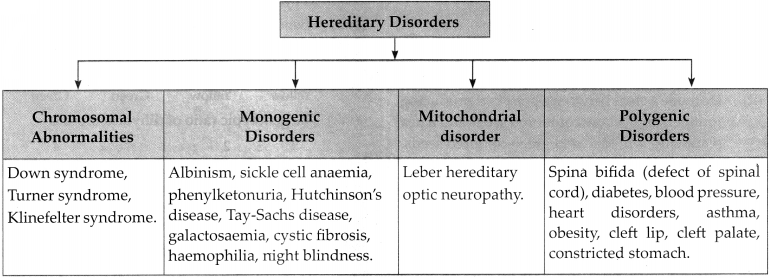
Class 9 Science Chapter 12 Study of Sound Intext Questions and Answers
Question 1.
How do specific traits or characteristics appear in organisms? (Can you tell; Textbook Page No. 180)
Answer:
- Information necessary for synthesis of a particular protein is stored in the DNA.
- The segment of DNA which contains all the information for synthesis of a particular protein is called a gene for that protein.
- To understand how a specific trait is expressed, let us consider plant height as an example.
- We know that there are growth hormones in plants. Increase in the height of plants depends upon the quantity of growth hormones.
- The quantity of growth hormone produced by a plant depends upon the efficiency of the concerned enzyme.
- Efficient enzymes produce a greater quantity of the hormone due to which the height of the plant increases.
- However, if the enzymes are less efficient, a smaller quantity of hormone is produced leading to the stunting of the plant.
- Thus, the expression of traits is controlled by the genes.
Question 2.
Show the monohybrid cross between (RR) and (rr) and write the phenotypic and genotypic ratio of F
2
generation. (Use your brain power; Textbook Page No. 187)
Answer:
Parental Generation (P
1
)
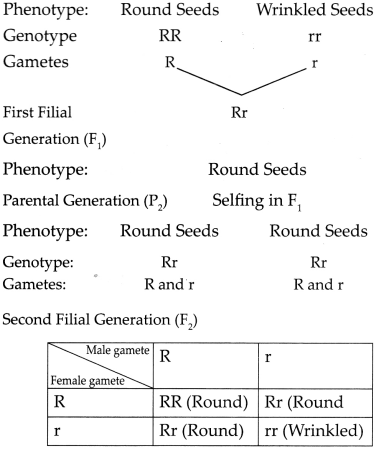
Phenotypic ratio : 3 Round : 1 Wrinkled
Genotypic ratio : 1 RR : 2 Rr : 1 rr

Question 3.
Why did the characteristic of the Rounded- Yellow seeds alone appear in the Fj generation but not the characteristic of the wrinkled- green seeds? (Use your brain power; Textbook Page No. 187)
Answer:
- Rounded-Yellow seeds is a dominant characteristic whereas wrinkled-green seeds is a recessive characteristic.
- Therefore only the characteristic of Rounded- Yellow seeds appeared in the F1 generation.
Question 4.
Do all boys and girls of your class look alike? (Think about it; Textbook Page No. 179)
Answer:
- No, all the boys and girls of my class do not look alike.
- There is a lot of variation among them.
Question 5.
Carefully observe your classmate’s earlobes. (Observe; Textbook Page No. 179)
Answer:
- Most of the classmates have free earlobes while very few have attached ear lobes.
- This shows that in humans free earlobes is a dominant characteristic whereas attached earlobe is a recessive characteristic.
Question 6.
Irrespective of all of us being humans, what difference do you notice in our skin colour? (Observe; Textbook Page No. 179)
Answer:
- Irrespective of all of us being humans, there is a lot of variation in our skin colour. Some people are light-skinned while some are dark-skinned.
- The difference in skin colour is due to the gene responsible for the production of the pigment melanin.

Question 7.
All of you are in std. IX. Why then are some students tall and some short? (Observe; Textbook Page No. 179)
Answer:
Our height is decided by gene. People who are tall have genes for tallness whereas people who are short have genes for shortness and hence the variation.
Class 9 Science Chapter 12 Study of Sound Additional Important Questions and Answers
Choose and write the correct option:
Question 1.
The similarities and differences are all the effect of
(a) Heredity
(b) Fertilization
(c) Evolution
(d) Natural selection
Answer:
(a) Heredity
Question 2.
Each chromosome appears midway during cell division.
(a) Circular
(b) Rod-shaped
(c) Dumbbell-shaped
(d) Bottle-shaped
Answer:
(c) dumbbell-shaped
Question 3.
The chromosome in which the centromere is exactly at the mid-point is called chromosome.
(a) sub-metacentric
(b) metacentric
(c) acrocentric
(d) telocentric
Answer:
(b) metacentric

Question 4.
The chromosome in which the centromere is somewhere near the mid-point is called chromosome.
(a) metacentric
(b) acrocentric
(c) sub-metacentric
(d) telocentric
Answer:
(c) sub-metacentric
Question 5.
The chromosome in which the centromere is near one end of the chromosome is called chromosome.
(a) metacentric
(b) acrocentric
(c) sub-metacentric
(d) telocentric
Answer:
(d) telocentric
Question 6.
Sex chromosomes are called
(a) homologous chromosomes
(b) autosomes
(c) allosomes
(d) metacentric chromosomes
Answer:
(c) allosomes
Question 7.
Which of the following is absent in RNA?
(a) Adenine
(b) Uracil
(c) Cytosine
(d) Thymine
Answer:
(d) Thymine

Question 8.
DNA was discovered by
(a) Watson and Crick
(b) Frederick Miescher
(c) Gregor Johann Mendel
(d) Robert Brown
Answer:
(b) Frederick Miescher
Question 9.
The double helix model of DNA was produced by
(a) Watson and Crick
(b) Frederick Miescher
(c) Gregor Johann Mendel
(d) Robert Hooke
Answer:
(a) Watson and Crick
Question 10.
The molecule of RNA which is a component of the ribosome organelle is called a
(a) mRNA
(b) tRNA
(c) rRNA
(d) DNA
Answer:
(c) rRNA
Question 11.
In a monohybrid cross, the phenotypic ratio of F, generation is
(a) 1 tall: 3 dwarf
(b) 2 tall: 2 dwarf
(c) 3 tall: 1 dwarf
(d) 3 tall: 2 dwarf
Answer:
(c) 3 talhl dwarf

Question 12.
arises due to either inheritance of only X chromosome from parents or due to inactivation of the gender-related part of X-chromosomes.
(a) Down syndrome
(b) Turner syndrome
(c) Klinefelter syndrome
(d) Albinism
Answer:
(b) Turner syndrome
Question 13.
Progenies of normal man and sufferer woman for sickle-cell anaemia will be
(a) all normal
(b) 25% normal and 75% sufferer
(c) all carrier
(d) all sufferer
Answer:
(c) all carrier
Question 14.
is a mitochondrial disorder.
(a) Down syndrome
(b) Cleft palate
(c) Spina bifida
(d) Leber hereditary optic neuropathy
Answer:
(d) Leber hereditary optic neuropathy
Question 15.
is a monogenic disorder.
(a) Haemophilia
(b) Cleft palate
(c) Diabetes
(d) Spina bifida
Answer:
(a) Haemophilia

Question 16.
is a recessive character of pea plant.
(a) Round shape of seeds
(b) White colour of flowers
(c) Green colour of pods
(d) Inflated shape of pods
Answer:
(b) White colour of flowers
Question 17.
is a dominant character of pea plant.
(a) Dwarf height
(b) Yellow colour of pod
(c) Yellow colour of seeds
(d) Terminal position of flower
Answer:
(c) Yellow colour of seeds
Question 18.
is a dominant character in human beings.
(a) Non-rolling tongue
(b) Attached ear lobe
(c) Absence of hair on arms
(d) Free ear lobe
Answer:
(d) Free ear lobe

Question 19.
is a recessive character in human beings.
(a) Absence of hair on arms
(b) Black and curly hair
(c) Free earlobe
(d) Presence of hair on arms
Answer:
(a) Absence of hair on arms
Question 20.
If one parent is normal and one parent is carrier of sickle-cell anaemia, then the progenies will be
(a) all normal
(b) 50% normal and 50% carrier
(c) 50% carrier and 50% sufferer
(d) all carrier
Answer:
(b) 50% normal and 50% carrier
Question 21.
If one parent is carrier and one parent is a sufferer of sickle-cell anaemia, then the progenies will be
(a) 50% normal and 50% carrier
(b) all sufferers
(c) 50% carrier and 50% sufferer
(d) all carrier
Answer:
(c) 50% carrier and 50% sufferer
Find the odd man out:
Question 1.
Adenine, thymine, cytosine, uracil
Answer:
Adenine. It is a purine whereas the others are pyrimidines.

Question 2.
Axillary flower, green pod, green seed, inflated pod
Answer:
Green seed. It is a recessive character of pea plant whereas the others are dominant characters.
Question 3.
Constricted pod, purple flower, axillary flower, yellow seeds.
Answer:
Constricted pod. It is a recessive character of pea plant whereas the others are dominant characters.
Question 4.
Green seeds, wrinkled seeds, terminal flower, green pod.
Answer:
Green pod. It is a dominant character of pea plant whereas the others are recessive characters.
Question 5.
Attached ear lobes, brown and straight hair, non-rolling tongue, presence of hair on arms.
Answer:
Presence of hair on arms. It is a dominant characteristic of human beings whereas the others are recessive characters.
Question 6.
Cystic fibrosis, albinism, spina bifida, sicklecell anaemia.
Answer:
Spina bifida. It is a polygenic disorder whereas the others are monogenic disorders.

Question 7.
Fiutchinson’s disease, phenylketonuria, nightblindness, leber hereditary optic neuropathy.
Answer:
Leber hereditary optic neuropathy. It is a mitochondrial disorder whereas the others are monogenic disorders.
Complete the analogy:
a. Tall plant: Phenotype :: Tt:
b. Dominant trait : Axial position of flower :: Recessive trait:
c. Women : 44 + XX :: Men :
d. Adenine and Guanine : Purine :: Cytosine and Thymine :
Answer:
a. Genotype
b. Terminal position of flower
c. 44 + XY
d. Pyrimidine
Match the columns
Question 1.
| Column 1 | Column 2 | Column 3 |
| (1) Leber hereditary optic neuropathy | (a) 44 + XXY | (i) Pale skin, white hairs. |
| (2) Diabetes | (b) 45 + X | (ii) Men are sterile. |
| (3) Albinism | (c) Mitochondrial disorder | (iii) Women are sterile. |
| (4) Turner syndrome | (d) Polygenic disorder | (iv) This disorder arises during development of zygote. |
| (5) Klinefelter Syndrome | (e) Monogenic disorder | (v) Effect on blood- glucose level. |
Answer:
(1 – c – iv),
(2 – d – v),
(3 – e – i),
(4-b- Hi),
(5 – a – ii)

Question 2.
| Column ‘A’ | Column ‘B’ |
| (1) Yellow and rinkled | (a) yyrr |
| (2) Green and round | (b) YyRr |
| (3) Yellow and round | (c) YYrr |
| (4) Green and wrinkled | (d) yyRr |
Answer:
(1 – c),
(2 – d),
(3 – b),
(4 – a)
Question 3.
| Column ‘A’ | Column ‘B’ |
| (1) Tay-Sachs disease | (a) Multifactorial disorder |
| (2) Diabetes | (b) Destruction of erythrocytes |
| (3) Sickle-cell anaemia | (c) Absence of melanin |
| (4) Albinism | (d) Monogenic disorder |
Answer:
(1 – d),
(2 – a),
(3 – b),
(4 – c)

State whether the following statements are true or false. Correct the false statement:
Question 1.
Offsprings produced through asexual reproduction show greater variations as compared to those produced through sexual reproduction.
Answer:
False. Offsprings produced through asexual reproduction show minor variations as compared to those produced through sexual reproduction.
Question 2.
Information necessary for protein synthesis is stored in the RNA.
Answer:
False. Information necessary for protein synthesis is stored in the DNA.
Question 3.
The quantity of growth hormone produced by a plant depends upon the efficiency of the concerned enzyme.
Answer:
True
Question 4.
The chromosome in which the centromere is exactly at the mid-point is called telocentric chromosome.
Answer:
False. The chromosome in which the centromere is exactly at the mid-point is called metacentric chromosome.
Question 5.
RNA molecules are called master molecules.
Answer:
False. DNA molecules are called master molecules.

Question 6.
The pair of sex chromosomes are called autosomes.
Answer:
False. The pair of sex chromosomes is called allosomes.
Question 7.
In DNA, Adenine always pairs with thymine and cytosine always pairs with guanine.
Answer:
True
Question 8.
In humans there are 23 pairs of autosomes and one pair of allosomes.
Answer:
False. In humans, there are 22 pairs of autosomes and one pair of allosomes.
Question 9.
The phenotypic and genotypic ratios are not same.
Answer:
True
Question 10.
Phenotype means the pairs of genes responsible for the visible characteristics of organisms.
Answer:
False. Phentotype means external appearance of visible characteristics of organisms.

Question 11.
During gamete formation, in Pj generation the pair of gametes separate independently.
Answer:
True
Question 12.
Down syndrome is caused due to monosomy of X chromosome.
Answer:
False. Down syndrome is caused due to trisomy of 21st chromosome.
Question 13.
In Klinefelter syndrome, women are sterile.
Answer:
False. In Klinefelter syndrome, men are sterile as this disorder arises in men due to abnormality in sex chromosome.
Question 14.
If the father and mother are both sufferers or carriers of sickle-cell anaemia, their offsprings are likely to suffer from this disease.
Answer:
True
Question 15.
During fertilization, mitochondria is contributed by the sperm cell and egg cell(ovum).
Answer:
False. During fertilization, mitochondria is contributed by the egg cell (ovum) alone.
Question 16.
Polygenic disorders strictly follow Mendel’s principles of heredity.
Answer:
False. Polygenic disorders do not strictly follow Mendel’s principles of heredity.

Question 17.
Genetic material is transferred in equal quantity from parents to progeny.
Answer:
True
Give scientific reasons:
Question 1.
DNA molecules are called as ‘Master molecules’.
Answer:
- Molecules of DNA are present in all organisms from viruses and bacteria to human beings.
- These molecules control the functioning, growth and division (reproduction) of the cell.
- Genes present in the DNA are also responsible for transfer of hereditary characteristics from parents to offsprings.
- Therefore, DNA molecules are called as ‘Master molecules’.
Question 2.
Phenotypic and genotypic ratios are different.
Answer:
- Phenotype means external appearance or visible characteristics of organisms whereas the genotype is the pairs of genes responsible for the visible characteristics.
- The genes responsible for any particular character are present in pairs.
-
Though, there are two genes, the phenotype
depends on the presence of the dominant gene, e.g. Genotype for tall height of the plant is TT or Tt. - Therefore, phenotypic and genotypic ratios are different.
Question 3.
A carrier or sufferer of sickle-cell anaemia should avoid marriage with another carrier or sufferer.
Answer:
- Sickle-cell anaemia is a hereditary disease caused due to mutation of a single gene.
- It is a monogenic disorder that occurs due to changes in a gene during conception.
- If father and mother both are sufferers or carriers of sickle-cell anaemia, their offsprings are likely to suffer from the disease.
- Therefore, a carrier or sufferer of sickle-cell anaemia should avoid marriage with another carrier or sufferer.
Question 3.
Mitochondrial disorders are inherited from the mother only.
Answer:
- Mitochondrial DNA becomes defective due to mutation.
- During fertilization, mitochondria are contributed by the egg cell (ovum) alone.
- Hence, mitochondrial disorders are inherited from the mother only.

Question 4.
Tobacco smoking causes cancer.
Answer:
- Tobacco smoke contains harmful chemicals like pyridine, ammonia, aldehyde furfural, carbon monoxide, nicotine, sulphur dioxide etc.
- They cause uncontrolled cell division.
- Tobacco smoke is full of minute carbon particles which cause normal tissue lining of the lung to transform into thickened black tissue. This leads to cancer.
- Therefore, tobacco smoking causes cancer.
Define the following terms:
Question 1.
Gene
Answer:
The segment of DNA which contains all the information for synthesis of a particular protein is called a ‘gene’.
Question 2.
Chromosome
Answer:
The structure in the nucleus of the cells that carries the hereditary characteristics is called chromosome.
Question 3.
Genetics
Answer:
The branch of biology which studies the transfer of characteristics of organism from one generation to the next and genes in particular, is called genetics.
Question 4.
Heredity
Answer:
Transfer of characteristics from parents to offsprings is called heredity.
Question 5.
Homologous chromosomes
Answer:
If the pair consists of chromosomes are similar in shape and organization, they are called homologous chromosomes.

Question 6.
Heterologous chromosomes
Answer:
If the pair which consists of chromosomes are not similar in shape and organization, they are called heterologous chromosomes.
Question 7.
Genetic disorders
Answer:
Diseases or disorders occuring due to abnormalities in chromosomes and mutations in genes are called genetic disorders.
Distinguish between:
Question 1.
DNA and RNA
Answer:
| DNA | RNA |
| (i) In DNA, the sugar present is deoxyribose. | (i) In RNA, the sugar present is ribose. |
| (ii) In DNA, the nitrogen bases are adenine, guanine, cytosine and thymine. | (ii) In RNA, the nitrogen base thymine is replaced by uracil. |
| (iii) DNA is double stranded. | (iii) RNA is single-stranded. |
| (iv) DNA carries hereditary information | (iv) RNA helps in protein synthesis. |
Question 2.
Turner syndrome and Klinefelter syndrome.
Answer:
| Turner syndrome | Kline fater syndrome |
| (i) It is due to monosomy of sex chromosome. | (i) It is due to felter of sex chromosome. |
| (ii) Disorder in sex chromosome results in 44 + X condition. | (ii) Disorder in sex chromosome results is 44 + XY condition. |
| (iii) Seen in women. | (iii) Seen in men |
| (iv) Women suffering from this syndrome are sexually sterile. | (iv) Men suffering from this syndrome are sexually sterile. |
| (v) There is presence of total 45 chromosomes instead of 46. | (v) There is presence of total 47 chromosomes instead of 46. |
Write short notes on:
Question 1.
Albinism
Answer:
- Albinism is a monogenic disorder.
-
Our eyes, skin and hair have colour due to the brown pigment melanin. In this disease, the body cannot produce melanin.
![Maharashtra-State-Board-Solutions]()
- The skin becomes pale, hair are white and eyes are usually pink due to absence of melanin pigment in the retina and sclera.
Question 2.
Polygenic disorders.
Answer:
- Polygenic disorders are caused due to mutations in more than one gene.
- In most such cases, their severity increases due to effects of environmental factors on the foetus.’
- Common examples of such disorders are cleft lip, cleft palate, constricted stomach, spina bifida (a defect of the spinal cord), etc. Besides diabetes, blood pressure, heart disorders, asthma and obesity are also polygenic disorders.
- Polygenic disorders do not strictly follow Mendel’s principles of heredity.
- These disorders arise from a complex interaction between environment, life style and defects in several genes.
Question 3.
Turner syndrome.
Answer:
- Turner syndrome is a disorder arising in women due to abnormality in sex chromosomes.
- Turner syndrome arises due to either inheritance of only one X chromosome from parents or due to inactivation of the gender- related part of X-chromosomes.
- Instead of the normal 44 + XX condition, women suffering from Turner syndrome show a 44 + X condition.
- Such women are sterile i.e. unable to have children due to improper growth of the reproductive organ.
Answer the following questions:
Question 1.
What are the main objectives of National Health Mission?
Answer:
The main objectives of National Health Mission are:
- Strengthening of the rural and urban health facilities.
- Controlling various diseases and illnesses.
- Increasing public awareness about health.
- Offering financial assistance to patients through various schemes.

Question 2.
Which were the seven pairs of contrasting characteristics studied by Mendel in pea plant?
Answer:
The seven pairs of contrasting characters studied by Mendel in pea plant were as follows:
| Characters | Dominant | Recessive |
| Shape of the seed | Round(R) | Wrinkled (r) |
| Colour of the seed | Yellow (Y) | Green (y) |
| Colour of the flower | Purple (C) | White (c) |
| Shape of pod | Inflated (I) | Constricted (i) |
| Colour of pod | Green (G) | Yellow (g) |
| Position of flower | Axillary (A) | Terminal (a) |
| Height of the plant | Tall (T) | Dwarf (t) |
Question 3.
Name some dominant and recessive characteristics seen in human beings.
Answer:
Some dominant and recessive characteristics of human beings.
| Dominant | Recessive |
| Rolling tongue | Non-rolling tongue |
| Presence of hair on arms | Absence of hair on arms |
| Black and curly hair | Brown and straight hair |
| Free earlobe | Attached earlobe |
Question 4.
What is Klinefelter syndrome?
Answer:
- Klinefelter syndrome is a disorder arising in men due to abnormalities in sex chromosomes.
- In this disorder, men have one extra X chromosome, hence their chromosomal condition becomes 44 + XXY.
- Such men are usually sterile because their reproductive organs are not well developed.

Question 5.
How is the diagnosis for sickle-cell anaemia made?
Answer:
- Under the National Health Mission scheme, the ‘Solubility Test’ for diagnosis of sickle-cell anaemia is available at all district hospitals.
- Similarly, the confirmatory diagnostic test – ‘Electrophoresis’ is performed at rural and subdistrict hospitals.
Question 6.
Find out the Phenotypic ratio of the following:
(a) Round-Yellow
(b) Wrinkled-Yellow
(c) Round-Green
(d) Wrinkled-Green
Answer:
(a) Round-Yellow: 9
(b) Wrinkled-Yellow: 3
(c) Round-Green: 3
(d) Wrinkled-Green: 1
Phenotypic ratio: 9:3:3:1
Question 7.
Find out the Genotypic ratio of the following:
(a) RRYY
(b) RRYy
(c) RRyy
(d) RrYY
(e) RrYy
(f) Rryy
(g) rrYY
(h) rrYy
(i) rryy
Answer:
(a) RRYY -1
(b) RRYy-2
(c) RRyy-1
(d) RrYY-2
(e) RrYy-4
(f) Rryy-2
(g) rrYY – 1
(h) rrYy – 2
(i) rryy – 1
Genotypic ratio: 1:2:1:2:4:2:1:2:1

Draw neat and labelled diagrams of the following:
Question 1.
Structure of chromosome
Answer:
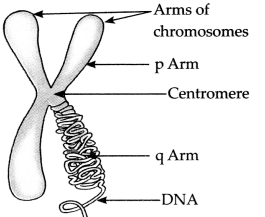
Question 2.
Types of RNA
Answer:
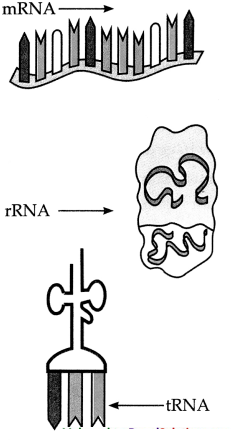
Answer the following questions:
Question 1.
What are the effects of tobacco consumption?
Answer:
- Smoking of cigarettes and bidis adversely affects the process of digestion.
- It causes a burning sensation in the throat and cough.
- Excessive smoking causes instability and trembling of fingers.
- It causes dry cough which leads to sleeplessness.
- Tobacco consumption can lead to shortening of life span, chronic bronchitis, pericarditis, cancer of the lungs, mouth, larynx (voice box), pharynx, urinary bladder, lips or tongue.
- The nicotine present in tobacco affects the central and peripheral nervous system. Arteries become hard i.e. it causes arteriosclerosis and hypertension.

Question 2.
Complete the table for number of chromosomes in different organisms.
Answer:
| Organism | No. of Chromosomes |
| Crab | 200 |
| Maize | 20 |
| Frog | 26 |
| Roundworm | 04 |
| Potato | 48 |
| Human | 46 |
| Dog | 78 |
| Elephant | 56 |
| Fruit fly | 08 |
| Mango | 40 |
